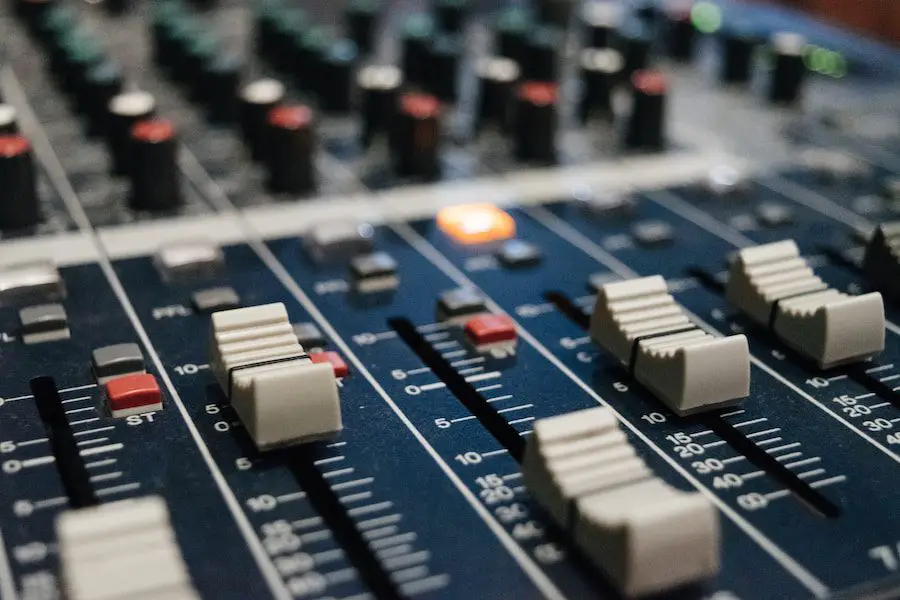Ducking is a common term used in the audio industry that refers to temporarily lowering the volume of one audio source when another is playing. This technique is often used in live sound reinforcement, broadcasting, and music production to prevent different sounds from clashing and creating unwanted noise.
Ducking is an audio processing technique that reduces one audio source’s volume when another is present. This technique is commonly used in radio broadcasting, podcasting, and music production to improve the clarity and intelligibility of the voiceover audio when music plays in the background.
Ducking can be achieved using various techniques, including side-chain compression, volume automation, and noise gates. Each technique has its advantages and disadvantages, and the choice of technique will depend on the project’s specific requirements. Understanding the concept of ducking is essential for anyone working in the audio industry, as it is a fundamental technique that can greatly improve the quality of the final product.
Table of Contents

What is Ducking?
When a sound engineer ducks one audio source, they create space for another sound to come through more clearly. For example, when a radio host speaks over a song, the volume of the music will be lowered automatically to make the voice more prominent.
Similarly, in a live concert, the volume of the music playing in the background may be lowered when the lead singer starts to sing so that the vocals are more audible.
How Ducking Works
Ducking uses a sidechain input to detect when a specific audio source is present. When the sidechain input detects the presence of the specified audio source, it automatically reduces the volume of the other audio source. The volume reduction is determined by the settings of the ducking processor, including the threshold, attack time, release time, and ratio.
The threshold sets the level at which the ducking processor starts reducing the volume of the other audio source.
The attack time determines how quickly the ducking processor reacts to the presence of the specified audio source. In contrast, the release time determines how quickly the ducking processor stops reducing the volume of the other audio source when the specified audio source is no longer present. The ratio sets the amount of volume reduction applied to the other audio source.
Applications of Ducking
Ducking has many applications in audio production. In radio broadcasting, ducking reduces the volume of background music or sound effects when the announcer speaks. This helps to improve the clarity of the announcer’s voice and makes it easier for the listener to understand what is being said.
In podcasting, ducking reduces the volume of background music or sound effects when the host or guest is speaking. This helps improve the conversation’s clarity and makes it easier for the listener to follow along.
In music production, ducking creates dynamic mixes by reducing the volume of one instrument when another is playing. For example, ducking can be used to reduce the volume of the bass guitar when the kick drum is playing, which helps to create a more punchy and powerful rhythm section.
Types of Ducking
Sidechain Ducking
Sidechain ducking is a type of ducking that is commonly used in music production. This technique involves using a sidechain compressor to reduce the volume of one track when another track is playing.
For example, if a vocal track is playing and a bass track is introduced, the volume of the vocal track will be automatically reduced to make room for the bass track. Sidechain ducking is often used to create a more dynamic mix where different elements of the music can be heard more clearly.
Sidechain ducking is also commonly used in radio broadcasting. In this case, the music volume is automatically reduced when the presenter starts speaking. This helps to ensure that the presenter’s voice can be heard clearly, without being drowned out by the music.
Manual Ducking
Manual ducking is another type of ducking that is commonly used in audio production. This technique involves manually reducing the volume of one track when another track is playing. For example, if a voiceover is playing and a music track is introduced, the volume of the music track can be manually reduced to make room for the voiceover.
Manual ducking is often used in video production, where a voiceover needs to be heard clearly over background music or sound effects. This technique can be particularly effective when used with fade-ins and fade-outs, which help create a smooth transition between different tracks.
Ducking in Audio Production
Ducking is a technique used in audio production to automatically reduce the volume of one audio signal when another audio signal is present. This technique is commonly used in radio broadcasting, podcasting, and music production to create a clearer and more intelligible mix.
Ducking in Mixing
Ducking is often used to make the vocals more prominent in a mix. For example, when a singer is singing over a backing track, the volume of the backing track can be automatically reduced when the singer is singing. This allows the vocals to cut through the mix and be more easily heard by the listener.
Another common use of ducking in mixing is to reduce the volume of the music when a voice-over is present. This technique is often used in commercials and video productions to make the voice-over more prominent and easier to understand.
Ducking in Mastering
In mastering, ducking is often used to create a more cohesive and balanced mix. For example, when mastering an album, the volume of each track can be automatically reduced when the next track starts. This creates a smoother transition between tracks and can help create a more consistent listening experience.
Another common use of ducking in mastering is to reduce the volume of the entire mix when a particularly loud section is present. This can help to prevent distortion and create a more balanced and controlled mix.
Overall, ducking is a powerful technique that can help improve an audio mix’s clarity and balance. Whether mixing music, producing a podcast, or creating a video production, adding ducking to your production toolkit can help you create a more professional and polished final product.
Final Thoughts on Audio Ducking
After reading this article, one can conclude that ducking is useful in audio production. It allows for the reduction of unwanted noise and improves the overall clarity of the audio. Ducking can be used in various scenarios, such as reducing background music during dialogue or lowering sound effects during narration.
Different ways to achieve ducking include using a compressor or a noise gate. The choice of which method to use depends on the specific needs of the project and the desired outcome.
It is important to note that while ducking can be an effective tool, it should be used with caution. Overusing ducking can result in an unnatural sound and can distract the listener. Finding the right balance and using ducking only when necessary is important.
Overall, ducking is a valuable technique in audio production that can greatly improve the quality of the final product. With the right approach and careful consideration, ducking can be a powerful tool in the hands of an experienced audio professional.
- Review of the ALABS IRON MINI-WL: A Powerhouse Wireless Microphone - October 4, 2023
- What is a Saturator in Music Production: A Brief Explanation - May 11, 2023
- What Are Rotary DJ Mixers? An Overview - May 11, 2023
SoundStudiomagic.com is a participant in the Amazon Services LLC Associates Program, an affiliate advertising program designed to provide a means for sites to earn advertising fees by advertising and linking to Amazon.com. We also participate in other affiliate programs which compensate us for referring traffic.

